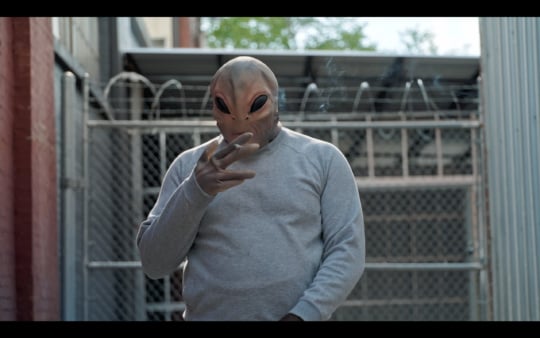
Art critic Arthur Danto wrote in 1964 that Warhol’s Brillo boxes “could not have been art” 50 years earlier, and the same could be said today of the row of 10-inch-tall emojis displayed near the entrance to the LOW Museum’s recent exhibition “Sext,” on view October 5-12. Aside from their physical materialization, what separates this line of seven enlarged photographic stickers from the emojis in the text you probably sent earlier today is the uncanny power of context. Because of the prestige granted to a gallery’s white walls, one is a work of art called Emojis while the other is simply the onscreen detritus of digital communication. On a smaller scale, it’s also because of context that this particular set of emojis constitutes sexting, defined in the curatorial statement as “sending sexually explicit messages primarily through mobile phones.” A cartoonish eggplant or peach may be innocent enough on its own, but each reveals its latent erotic connotation when placed in a series inaugurated by a wagging tongue and finished off by droplets of liquid. It turns out that whether something reads as sexually explicit, much like whether it counts as art or life, depends on the setting.
In the same gleefully disruptive spirit that has characterized programming at the LOW Museum since its founding in 2013, “Sext” blurs distinctions between fine art and the imagery of the Internet and iPhones, and, strikingly, between the roles of artist and curator. Instead of compiling original works by individual artists, the curators of “Sext”—who include LOW Museum director Pastiche Lumumba and executive advisor Hira Mahmood, as well as Sesali Bowen, Mahmood’s fellow grad student in gender and sexuality studies at Georgia State University—have gathered personal and anonymous digital interactions as “cultural artifacts,” transforming what was once online abstraction into concrete objects for gallery display.
Across from Emojis is an installation that, on one level, recreates a scene familiar to anyone who has casually dated in the age of Tinder: a modest couch and coffee table facing a television screen. The other components of the installation, however, insert today’s indirect, technologized sexual invitations into the physical situation they’re aimed at creating. The text printed repeatedly on the blanket draped across the couch, colored in a familiar red hue, reads “Netflix and Chill,” today’s code for “booty call.” Instead of being written in its common invitational form, here “Netflix and Chill” feels more like a generational mantra, and the comfort offered by its obliqueness is made obvious on the cozy fleece blanket. On a couch rests the wryly dubbed Pillow Talk, which bears screenshots of text conversations from an iPhone. On one pillow, a text from “Bae” asks, “u busy?” The response reads, “nope.” These items solicited more than a few laughs of chagrined identification from the twenty-somethings at the opening of “Sext”: either as senders or recipients (likely as both), we’ve seen these messages before.
Since the works in “Sext” aren’t attributed to artists, and given the exhibition’s blend of anonymity and intimacy, it’s possible for you to feel complicit in their production. Sometimes, as with Netflix and Chill, the indictment is relatively lighthearted, but elsewhere the tone is bleaker, unmasking the emotional distance so easily placed between two people communicating digitally. Screencaps, a series of photos of text conversations, Tumblr, and Instagram posts, is displayed on an iPhone mounted to the back wall of the gallery. One image shows this received message: “Come over. We can fuck and watch a good movie. I know you’re too afraid to be alone without me.” On the second pillow in Pillow Talk, “I don’t normally do this with black girls,” earns an incredulous, confused ellipsis in response.

One of the most poignant moments in the exhibition, another screencap, is also among its most incisive. “Miss you” reads the text received at 2:28am. Below is the iPhone’s automated comment: “The sender is not in your contact list,” along with the option to report the message as junk. By highlighting details like these, “Sext” draws attention to the potential self-delusions contained within technological interfaces themselves. With iPhone in hand, you’re never alone—unless, of course, you want to be. Technology seems to always be selling myths of absolute connection and deletion, but these options are dramatically less available IRL, where the messiness of desire and nostalgia and loneliness can’t be resolved so painlessly. What “Sext” demonstrates through its feats of recontextualization is that sexting isn’t separate from real life—sometimes it’s just too difficult to navigate our desires and needs (much less those of another person) in the blue light of a screen. “Sext” provides a thoughtful critique of the way we hook up now, another confirmation of the distinctive importance of the LOW Museum’s lively but clear-eyed perspective on contemporary art.
Logan Lockner is a writer living in Atlanta. He studied English literature and linguistics at Emory University and University College London, concentrating on the work of Virginia Woolf. His writing has appeared online in Oxford American, Paste, the Los Angeles Review of Books, and elsewhere. He is a participant in the second cycle of the Emerging Art Writers Mentorship Program.





